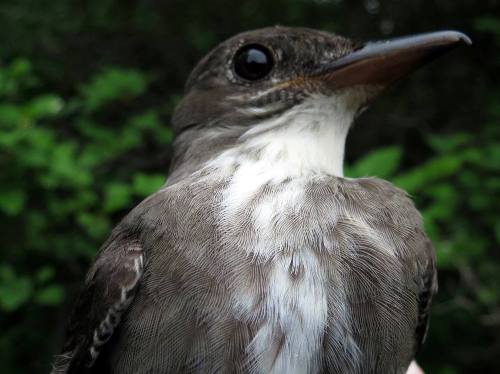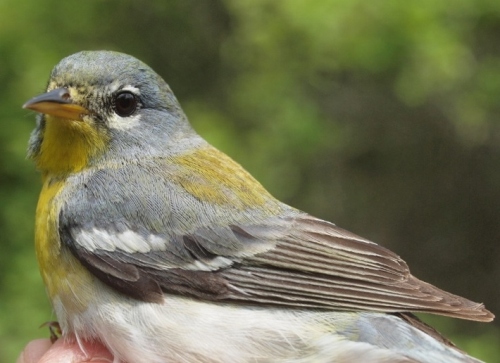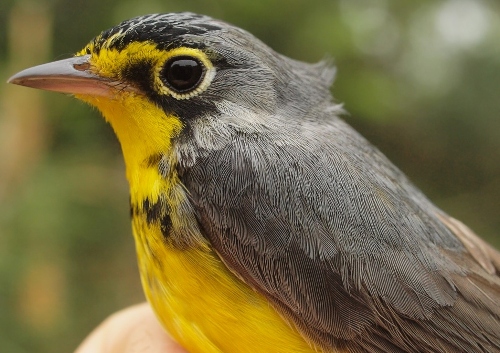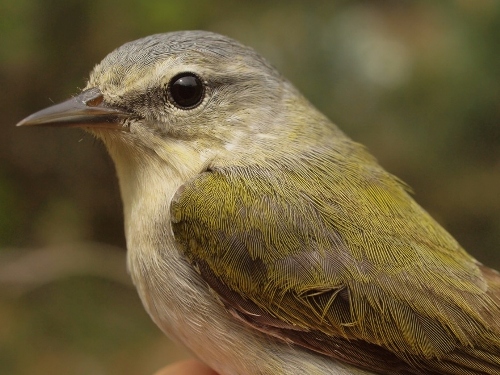|
|
THIS WEEK |
THIS SPRING |
2014 TOTAL |
SITE TOTAL |
|
# birds (and species) banded |
318 (40) |
1282 (69) |
1282 (69) |
47592 (115) |
# birds (and species) repeat |
73 (19) |
271 (33) |
271 (33) |
9405 (70) |
|
# birds (and species) return |
19 (10) |
123 (23) |
123 (23) |
1557 (38) |
|
# species observed |
99 |
141 |
142 |
209 |
|
# net hours |
528.0 |
2805.4 |
2805.4 |
81988.7 |
|
# birds banded / 100 net hours |
60.2 |
45.7 |
45.7 |
58.0 |
|
|
Note: table does not include nocturnal banding (owls) |
Banders-in-charge: Simon Duval, Gay Gruner
Assistants: Sue Bishop,
Marc Boisvert, Carl Bromwich, Luke Currin, David Davey, Jean Demers, Alison Hackney, James Junda, Lisa Keelty, Helen Kohler, Marcel Lebeau, Barbara MacDuff, Don MacDuff, Betsy McFarlane, Ana Morales, Benoît Piquette, Catherine Russell, Ahmad Shah, Clémence Soulard, Christiane Tremblay
Notes: In the nine previous years of Spring Migration Monitoring Program, we never quite managed to break the threshold of 300 birds banded in a week; now we have passed that twice in the same season, with 305 in week 7, and a new record of 318 this week. In the process, the previous spring season record of 994 has been shattered – and the 69 species banded to date has also surpassed the previous spring high of 68, set just last spring. Overshadowed by the number of birds banded are the repeats and returns, both also at record levels. Meanwhile diversity remained very high for a third consecutive week, falling just shy of 100 species observed, and with the season total of 141 also somewhat above average.

We typically only observe one or two Olive-sided Flycatchers at MBO each year; in our tenth year of operation we have now finally banded one for the first time.
(Photo by Simon Duval)
|
By this point in the season, the number of new species is of course getting smaller by the week. For the second time this spring we banded a species new to MBO, Olive-sided Flycatcher. Two other flycatchers were banded for the first time this spring (Yellow-bellied and Great Crested), as was Northern Parula. Meanwhile the late arrivals among species observed were the aforementioned Olive-sided Flycatcher, as well as Great Egret, Black-billed Cuckoo, Eastern Wood-Pewee, Pine Warbler, and Scarlet Tanager.
This week’s
top 10 [last week's top 10 in brackets]
#
individuals banded |
mean # individuals observed daily |
1. Tennessee Warbler (100) [2] |
1. Ring-billed Gull (129) [1] |
2. Traill's Flycatcher (25) [-] |
2. Red-winged Blackbird (34) [2] |
3. Cedar Waxwing (24) [-] |
3. Cedar Waxwing (34) [-] |
3. Wilson's Warbler (24) [9] |
4. American Crow (29) [9] |
5. Magnolia Warbler (21) [1] |
5. Tennessee Warbler (28) [5] |
6. Northern Waterthrush (13) [4] |
6. Yellow Warbler (13) [3] |
7. Red-winged Blackbird (11) [7] |
7. Song Sparrow (12) [4] |
| 8. Common Yellowthroat (10) [6] |
8. American Goldfinch (11) [8] |
| 9. Blackpoll Warbler (9) [-] |
9. Common Grackle (11) [-] |
9. Common Grackle (9) [-]
|
9. Common Yellowthroat (10) [7]
|
|
This
week’s record count of birds banded was fueled overwhelmingly by Tennessee Warblers, which accounted for over 30% of the total. This is a record number of Tennessee Warblers for a week in any season – and more in one week than any previous entire spring! Although in distant second place, the count of Traill’s Flycatcher is similarly impressive – until now, our record high for a spring season was 19 in 2010, so to exceed that in a single week is noteworthy. Tied for third place, Wilson’s Warbler was not far off, with 24 banded this week, compared to a spring record of 28 in 2009. Meanwhile, the other species tied for third place, Cedar Waxwing, has become the first species ever to exceed 200 individuals banded in a single spring season. Although dropping to fifth place this week, the ongoing strong migration of Magnolia Warblers was enough to also drive it to a new spring season record total of 79 (so far). Similarly, the steady movement of Northern Waterthrushes continued for a third week in a row, and the season total to date of 46 means that the spring count has increased to a new high for a fourth consecutive year. Red-winged Blackbird and Common Yellowthroat were again banded in similar numbers to last week, while Blackpoll Warbler and Common Grackle increased and rounded out the top ten.
Ring-billed Gull was the most abundant species observed in week 9 in 2005, 2006, and 2009, but averaged fewer than 10 individuals per day during this period over the past four years, so it was quite surprising to see record numbers this year (even in the three previous years when it was the top species, the mean daily count only ranged from 33 to 43). Most other years Red-winged Blackbird has been the most common bird during this period, with mean daily counts ranging from the low 30s to high 40s, so this week’s results were typical in that regard. Cedar Waxwing has now been in the top three for week 9 for four of the past five years, although prior to that is rather uncommon during this period. American Crow numbers were fairly typical, while Tennessee Warbler counts were higher than ever before in spring, parallel to the record number banded. All of the species in the bottom half of the top ten were considerably less numerous, and are local breeders, although some of the individuals observed may well have still been migrants passing through to more northern breeding locations.
|

A Northern Parula, the 21st warbler species banded at MBO this spring. Note that
this individual is easily recognizable as a second-year bird by virtue of the contrast
between the brownish juvenile primaries, secondaries, and primary coverts, contrasting with the blue-gray of the greater coverts.
(Photo by Simon Duval)

Another of the less common warbler species at MBO; this Canada Warbler brought the spring season total to 7 individuals, somewhat higher than the average of 4.
(Photo by Simon Duval)
|




